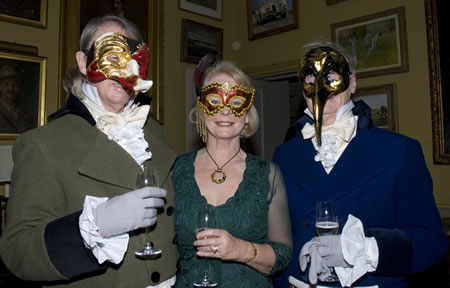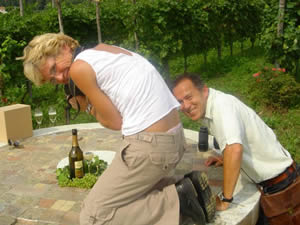
Venice comes to Bath
A Venetian masked ball and wine dinner at The Bath PrioryBath, February 21, 2008 Prosecco, as every school boy knows, is the favourite tipple of the Venetians. Go out for cicchetti – nibbles and drinks Venetian style – and you’re likely as not to find yourself downing quick, small glasses of this so-easy-to-drink fizz, one small glass following another, and another, and another as you wander happily through the alleys and canals of Venice. Prosecco used to be the Venetians’ best kept secret – a wine you rarely encountered outside of the watery city because, it was claimed, those crafty and wily Venetians preferred to keep it to themselves. No more: Prosecco has boomed big time, oceans of vineyards have been planted well beyond the classic Valdobbiadene-Conegliano heartland, and the world is now awash with the stuff. However, that is to take nothing away from the best wines, the Proseccos I’d like to think those crafty Venetians still prefer to keep for themselves.
Sometimes such wines are allowed out into the wider world. Recently the Bath Priory Hotel, one of the loveliest, most English of luxury hotels, was transformed, through Italian alchemy and the power of wine to transport, into a night of warmth and wonder, Venetian style for a Venetian evening of wine and food. The Bath Priory is located in a 19th century private dwelling that once formed part of the Priory of Bath Abbey. But on this night, it almost felt as if we were in a Palladian villa in the Veneto, somewhere along the Canale di Brenta. What a frisson of intrigue as we made our way to the splendid drawing room, furnished with antiques and original works of art. The guests had clearly entered into the Venetian spirit of the evening, for there were Harlequins, crook-nosed Pulcinellas, beautiful masked Contessas, a roguish Scaramuccia in a splendid velvet suit, a mysterious Commendatore, stern and unyielding, there it seemed to damn Don Giovanni to the eternal fires of hell. The company mingled, laughed, flirted, coyishly tried to discover identities while enjoying flutes of Prosecco di Valdobbiàdene Bisol Crede, and nibbling on cicchetti such as baccala mantecato alla Veneziana and other typical canapés.
This Venetian evening was the launch of a year of events – talks, lunches, wine dinners, demonstrations and more – at the Bath Priory. Tonight’s evening was hosted by Roberto Cremonese, export manager of Prosecco Bisol accompanied by the always effervescent Dacotah Renneau, who looks after the company’s public relations. It was an opportunity to get to know not just the wines of Bisol, but also the cucina of the Veneto. Guest chef Giuseppe Silvestri, who is the Executive Chef for Harrods and formerly at the Hotel Londra in Venice, was working alongside the Bath Priory’s acclaimed one-star Michelin Head Chef Chris Horridge to create a menu that was at once authentically Venetian and also designed to show off a range of wines from the Veneto. Vito Scaduto, the Bath Priory’s Wine Adviser, had worked closely with Roberto and Giuseppe to select the wines to accompany the meal as well as to oversee the service.
The Bisol family produce a range of Proseccos entirely from grapes grown on their own vineyards, which extend over some 45 hectares located on 16 farms across the DOC region, planted at altitudes between 250 and 300 metres. The soil of this steep balcony of hills is complex, varying from yellow and bluish marl, calcareous clay, ash-gray marine sand and compact clay. Vineyards in each zone produce grapes with entirely unique characters. The Bisols are thus almost unique in being able to produce a range of cru Proseccos that express the uniqueness of their local habitats.
Crede, for example, is produced from Prosecco grapes together with some Verdiso and Pinot Bianco, grown on marine clays known as ‘crede’. This soil type allows the grapes to develop in richness allied with varietal aromas. The wine has a good depth of flavour, allied with delicate floral scents. Prosecco Vigneti del Fol, by contrast, comes from Prosecco grapes grown near the Cartizze zone on clay that overlayers a base of marine sandstone. The wine is altogether different in character, richer, fruitier, and with a higher degree of residual sweetness that gives it a full roundness in the mouth.
The first course was branzino Muranese e radicchio Treviso Jada with polenta. The pan-roasted sea bass was served with a characteristically Venetian agrodolce sauce of raisins, onions, vinegar and Treviso radicchio, on a bed of wet polenta. The fuller, sweeter flavour of Prosecco Vigneti del Fol matched this dish well.
Prosecco is a unique sparkling wine that has its own character and most certainly does not try and imitate wines such as Champagne. The wine is made sparkling by the cuvée close or Charmat method of secondary fermentation in sealed, pressurised tanks, as opposed to in the bottle, and this method, less costly and laborious, seems best to preserve the gentle fruit and varietal character of Prosecco. And yet, yet: one senses that producers here cannot resist the temptation to try gild gold. While on the one hand proclaiming the uniqueness of Prosecco and wanting to establish its own identity and place in the marketplace, at the same time they may yearn for the prestige that comes from sparkling wines made by the metodo classico.
We sampled two such wines. The first was Bisol’s Talento Riserva Brut 2001, made from Pinot Bianco, Chardonnay and Pinot Nero. This was a golden, rich wine with biscuity flavours and character that seemed almost oaky (though apparently the wine has seen no wood). It was powerful in the mouth, full-bodied but, being older, lacked somewhat the freshness and fruit, and, yes, the charm of the Proseccos.
Our next course was another Venetian classic, a risotto made with Vialone Nano rice, squid ink, and scampi. This was partnered by another metodo classico wine, Talento Rosé Brut 2001. This 100% Pinot Nero rosé had a lovely delicate colour, and an attractive nose of soft fruits. On the palate, it was perhaps too dry to accompany the food, and it seemed to lack the fruit and the fuller roundness of the Prosecco. Perhaps if we had sampled it first, it would have shown better, as it is often difficult to follow a sweeter wine with a dry. It is not that either of these wines were in any way deficient. It’s rather that, on this Venetian occasion, both seemed somehow out of place and I would have been far happier to drink Prosecco throughout.
Of course, it is always difficult to create an entire meal around sparkling wines, and I’m glad to say that for the next course, faraona or guinea fowl braised in red wine, we were able to enjoy a pair of reds from the Valpolicella. Guinea fowl is a much undervalued bird: this was full of flavour, cooked to perfection, and with a rich winey sauce that was deeply satisfying. We sampled “Seccal” Valpolicella Classico Superiore ripasso 2004 and “Nicolis” Amarone della Valpolicella Classico 2003. The former, made by refreshing the wine over the lees of Amarone grapes to add a layer of richness, partnered the guinea fowl beautifully. The Amarone, richer, with deep, baked raisiny fruit from the heatwave summer of 03, was definitely more of a contemplative vino da meditazione, a complex and powerful wine simply to savour and sip on its own, without the distraction of either food or company.
Prosecco di Valdobbiàdene Cartizze is a wholly unique and special wine, as invigorating as it is charming, and it was a perfect wine to keep the evening exciting and vivid. The Cartizze denominazione applies to selected Prosecco grapes cultivated on the well-exposed Cartizze hilltop, a unique microclimate and terrain characterised by stony soil that remains humid throughout the summer. Here, the Prosecco grapes ripen slowly, yet reach a very high degree of ripeness, resulting in a particular style of Prosecco that is highly prized – and commands prices to match.
Cartizze is always lightly sweet, almost honeyed in bouquet and flavour, with a complexity and depth that belies its immediate charm. It can be enjoyed as an aperitivo or as an accompaniment to desserts, as in this case, paired with a not-too-sweet torta di mela alla grappa.
Finally, to finish, a delightful deconstructed version of the Venetian classic tiramisù (‘pick me up’ in Venetian dialect): a rectangular plate with three different glasses and Savoiardi biscotti. The idea was to dip, first into a magnificent sweet ‘Duca di Dolle’ passito Prosecco, then espresso, and finally into a zabaglione made with the same wine. In truth, enjoyable though this dessert was, the magnificent passito rarity was far too good for dunking and best sipped on its own, complex, caramelly, rich in flavour yet only lightly sweet, an outstanding contemplative after-dinner drink.
What an evening of Venetian foods and wines, served with terrific style and efficiency within the splendour of the Bath Priory. And what a magnificent opportunity to experience the Bisol family’s crus Proseccos and other sparkling wines in all their variety.
What, then, of the stern and unforgiving Commendatore? I wonder, did he enjoy the evening? After a night of sparkling company and wines, such exquisite Venetian flavours, and the comfort and splendour of the Bath Priory Hotel, I can confirm, with the utmost certainty, that he did.
The Bath Priory Hotel has a season of events and special programs, while in November, it hosts an Italian Festival of Food and Wine. For further information, visit www.thebathpriory.co.uk, telephone 01225 331922 or email mail@thebathpriory.co.uk.
For further information about Prosecco Bisol wines visit www.bisol.it or contact Dacotah Renneau telephone 07956 66813 or email info@dacotah.biz.
![]()
|Home| |QP New Media| |Kim's Gallery|
Copyright © Marc and Kim Millon 1997-2007
![]()





